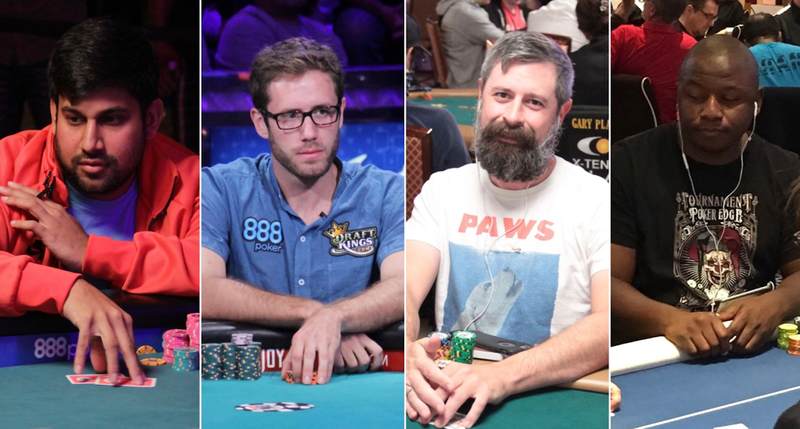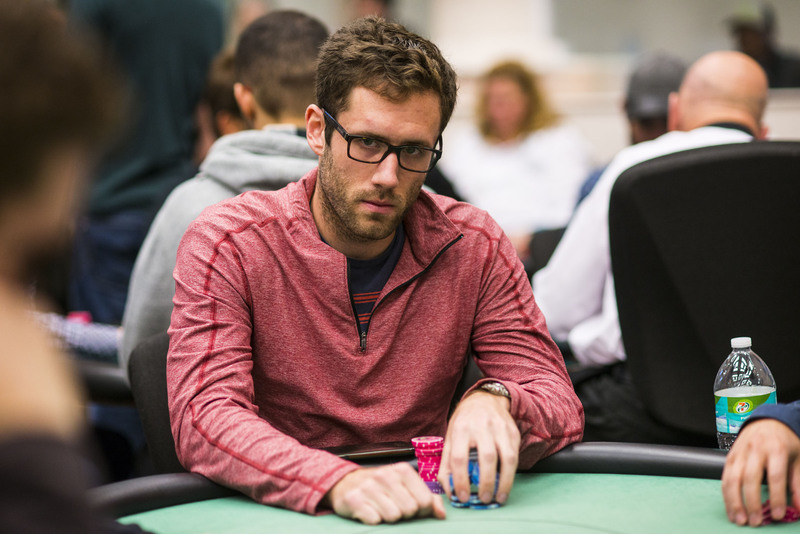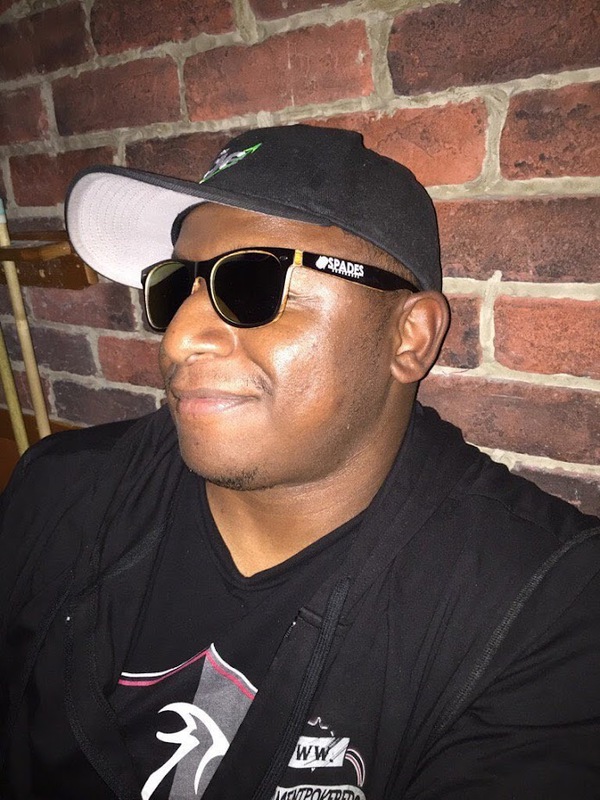






Poker Strategy: Street By Street Tournament Bet SizingTop Pros Ankush Mandavia, Jake Toole, Justin Young, and Carlos Welch Share Their Thoughts |
|
|

The Pros: Ankush Mandavia, Jake Toole, Justin Young, and Carlos Welch
Craig Tapscott: When you have a big hand preflop in late position, and a player has already opened, what are the variables that determine what your bet sizing will be if you three-bet?
Ankush Mandavia: It’s very dependent on game flow, history, the hands that have been shown down, position, and stack sizes. Even the pair you hold matters quite a bit.
If you have aces and a solid player opens, and you have sub 20 big blinds (bb), a lot of players would opt to call. Additionally, it depends on the stacks behind you and how squeeze happy they are. If you have been calling a lot of hands, you might want to mix in some big pair calls in order to be balanced. Usually at deeper stacks (40 bb+) you are going to want to three-bet for value. If you’ve been playing a lot of hands and have shown down hands such as J-9 on three-bets, you are going to want to continue three-betting big pairs.
But sub 40-bb stacks is where it gets a bit tricky and more dynamic. For example, if a recreational player that has played almost no hands opens and we have jacks on 35 bbs, we’re probably not going to want to get stacks in versus him and will opt to flat. If a solid reg opens, we have no problem getting jacks in versus them and that stack.
Another thing to think about is if you have someone in the big blind willing to play a lot of hands and you have a short stack. In that case you might want to call to keep their hands in, let them catch a piece of the board, and then get your stack in.
 Jake Toole: Effective stack depth, as well as stack sizes still left to act, are two important factors to consider when reraising an opener. My standard approach is to three-bet a linear range with deeper stacks and start to three-bet a polarized range as stacks get shorter. I’ll mix in more calls with hands that don’t want to get shoved on, as well as some traps if there are shorter stacks still left to act.
Jake Toole: Effective stack depth, as well as stack sizes still left to act, are two important factors to consider when reraising an opener. My standard approach is to three-bet a linear range with deeper stacks and start to three-bet a polarized range as stacks get shorter. I’ll mix in more calls with hands that don’t want to get shoved on, as well as some traps if there are shorter stacks still left to act.
Typically, in tournaments, the stacks are shallower, which tends to allow reraises to be smaller. If a 25-30 bb stack opens for 2x, my reraise size will be anywhere from 5.5-6x in position, and 6-7x from out of position.
Justin Young: The very first thing I consider is the playing styles and stack sizes of the players directly and indirectly involved in the hand. The player profile of the original raiser takes precedence with the strategy, but there are times when you are targeting a player behind you yet to act. You can create optimum squeeze spots by just flatting the raise for a shove stack (18-32 bbs), or a larger stacked aggressive player who can widely put in a third bet for you.
To use this strategy, you must have a strong understanding of your table dynamics. I would not even consider flatting the raise unless you have been at the table for a long time. If you choose the more conventional route of three-betting, the obvious things to look at first is the stack sizes of yourself and the opening raiser. You can generally just use the smaller stack of the two players to plan your strategy.
In tournaments, especially late, the hands will play themselves due to the smaller stacks involved. If a shorter stack (5-15 bbs) is involved, then an “all in” is required if you are the shorter stack. A simple smaller three-bet can be used to isolate the opener if he/she has the short stack. My personal preference is around 2.4x the open. Generally, this will result in a fold or a shove from the opener, but the times he does call the raise your hand will play pretty well in position.
Once the players get somewhat deeper things get more complicated. Your sizing should be tailor-made for the style of your opponent. Though I do hate to pigeonhole players into only two categories, you want to think about whether the player is more likely to four-bet/fold or whether he/she tends to flat three-bets fairly wide.
In order to exploit the more aggressive player, you will want to make your three-bet size conducive to being four-bet, where his bet will leverage the smaller stack or put the smaller stack all in. As an example, if the opener raised two bbs off a 60-bb stack, you would want to keep the three-bet on the smaller side, let’s say 5.5 bbs. Now we can comfortably make a four-bet that will leverage his stack.
On the flip side, if he is working with 35 bbs you can make it on the bigger side 6.6 bbs, which will allow a standard four-bet shove from your opponent. For the more “sticky” opponent you want to make your sizing bigger in general (3x-4x) as they tend to call, but in addition you want to gauge how your hand will play post-flop. Not only the strength of your hand, but also the skill of your opponent. This allows for easier decision making on future streets.

For one, if I expect this to be a tighter player with a stronger range, I will increase my size with the top of my range and avoid three-betting him with the bottom. This is obviously exploitable but doing so would require my opponent to fold hands he really wants to play, and most people are unable to do this. If instead, this is a loose player who I expect to be fairly weak post-flop, I will choose a smaller size as a default. The main purpose of this size is to isolate this player and play pots in position against him as often as possible. The smaller sizing allows me to play a wider range and control the size of the post-flop pot.
There are also variables that influence the decision to three-bet at all. If the opener is a good player, but the players behind me are not, I will flat here with my entire range. It does me no good to three-bet a good player who is unlikely to make big mistakes and price out the bad players who are likely to do so. Additionally, flatting your big hands here is a good idea when the average stack size starts to decrease and the players behind are short and aggressive enough to attack your flat with all in squeezes.
Craig Tapscott: Let’s say you three-bet a big pair and get called. How do you determine bet sizing on the flop? What’s your sizing on the turn or river against someone that you have position on?
 Ankush Mandavia: Overpair sizing on flops when called are dependent on board texture and range advantage. If you get called on a 40-bb effective stack preflop and the flop comes 10-9-8 and we have aces, we’re going to want to pot control the majority of the time and check back. We have to consider our opponents calling range and make the sizing and bet decisions based on that.
Ankush Mandavia: Overpair sizing on flops when called are dependent on board texture and range advantage. If you get called on a 40-bb effective stack preflop and the flop comes 10-9-8 and we have aces, we’re going to want to pot control the majority of the time and check back. We have to consider our opponents calling range and make the sizing and bet decisions based on that.
If our opponents are very mid pair/Broadway heavy, we have to proceed with caution. If they are capable of trapping us preflop we have to be aware of that. This consideration goes down a lot with shorter stacks, and you have to have the mentality that if they have it, they just have it.
The board texture matters a lot for sizing. For example, if we are on 30-bb stacks, and we three-bet A A
A and we get called. The flop comes Q
and we get called. The flop comes Q 5
5 3
3 , we can bet small because we’re not scared of protection. If we have red aces there, we might want to bet bigger since we’re worried about a spade rolling off. Most times with overpairs on boards with unders that are not coordinated, we’re going to have no problem barreling off.
, we can bet small because we’re not scared of protection. If we have red aces there, we might want to bet bigger since we’re worried about a spade rolling off. Most times with overpairs on boards with unders that are not coordinated, we’re going to have no problem barreling off.
But if we have K-K for example on 30 bbs and the flop comes A-x-x, we might want to bet small or check for pot control. It’s not a board we’re going to want to barrel off. Usually, these c-bet spots versus pros we’re going to want to be balanced and versus recreational players we’re going to want to bet a lot.
Jake Toole: My flop strategy with an overpair is always going to be dependent on the board texture. Understanding what flops favor the in-position player versus out of position player is very important. A normal sizing for a dryer board texture such as 10-5-2 in a three-bet pot will be one-third pot. When we have an overpair, it allows us to bet our full range, while understanding that on this board, our opponent is going to have very few stronger hands then ours. Which means we can really push our EV (expected value) and equity advantages on later streets.
It’s always going to depend on stack depth, especially in a tourney format, but typically I will size geometrically on blank turns to allow myself to have bluffs and continue to apply pressure with a shove on certain rivers.
Now let’s discuss pot control. This can come into play when there are turns or rivers that are considered bad for our range. In the above flop of 10-5-2, if we continuation bet and our opponent calls, he’s going to have quite a bit of 10x in his range. If the turn is a 10, we can safely check back and reevaluate on rivers, depending on what action we face.
 Justin Young: When I have a large pair in position of a heads-up pot, there are many ways to play them. The first thing I consider is the range of the person I am in the pot with. In most instances, I’m the preflop raiser and one of the blinds has made the call. If the call comes from the small blind the range is a bit more defined. This could mean everything from Broadway cards to medium/small pocket pairs, all the way to suited connectors. While that seems like an incredibly wide range, the range of the big blind is even larger. Especially over the last two to three years, the defending range of the big blind can be expanded to almost any two cards.
Justin Young: When I have a large pair in position of a heads-up pot, there are many ways to play them. The first thing I consider is the range of the person I am in the pot with. In most instances, I’m the preflop raiser and one of the blinds has made the call. If the call comes from the small blind the range is a bit more defined. This could mean everything from Broadway cards to medium/small pocket pairs, all the way to suited connectors. While that seems like an incredibly wide range, the range of the big blind is even larger. Especially over the last two to three years, the defending range of the big blind can be expanded to almost any two cards.
If I’m fortunate to have a flop where my pair is bigger than any card on board, I must be very thoughtful to try and get maximum value without putting much of my stack at risk. The board texture is the next thing to take into account. There are obvious wet and dry boards, but in addition there will be boards that should connect with the range of the opponent.
Once an assumed range is established and we consider the likelihood of our opponent connecting with the flop, we can start to formulate a plan to get maximum value. If we or our opponent has a bit of a shorter stack, our goal is to get all the chips in the middle at some point. The more straightforward examples are when we are playing anywhere with less than pot to 4x pot behind. We can size our flop/turn/river bets according to whether we believe they have a drawing range or a one-pair hand. Against perceived drawing hands, we want to front load the bets since missed draws tend to fold the river unless they back door into a pair.
When we are a bit deeper stacked, we have more options to attack our opponent. The goal is usually to get three streets of value from one pair hands and bluff catchers, but knowing if your opponent tends to give up on rivers is key. Checking the turn can ensure a pot-sized bet to be called on the river. It can also serve as a pot controlling tool, which is very important in a tournament format.
As an example, checking back when the board pairs on the turn (9 7
7 4
4 7
7 ) is a good way to protect yourself from possibly losing a big pot if they turn three of a kind. But when you do get favorable runouts against an ambitious top pair, then betting heavy is necessary. An example would be a J-2-2 flop where you are up against J-x most of the time. Here you can bet aggressively, a 40%/80%/120% (of pot) betting pattern is commonly used.
) is a good way to protect yourself from possibly losing a big pot if they turn three of a kind. But when you do get favorable runouts against an ambitious top pair, then betting heavy is necessary. An example would be a J-2-2 flop where you are up against J-x most of the time. Here you can bet aggressively, a 40%/80%/120% (of pot) betting pattern is commonly used.
Carlos Welch: I determine my bet sizing on the flop with an overpair based on board texture, effective stack size, and the range of my opponent. Generally, I bet around two-thirds pot on dynamic boards where the best hand possible changes on a lot of turn cards. On static boards I bet around one-third pot, where the best hand possible on the flop is very likely to remain the best hand on the turn.
If my overpair contains a blocker to the front door flush draw, I often use a slightly bigger size because my hand retains a lot of its equity on board changing run outs. If the board is extremely dry, I will bet even smaller than one-third pot. That’s how I play in theory, but I will make other sizing adjustments to exploit player specific tendencies. Also, I do mix in checks with overpairs in these situations some frequency of the time.
When my continuation bet is called, my opponent gets to the turn with a stronger range than he had on the flop. If the board changes in a way that strengthens many of those hands to a point where they are stronger than my pair, I will often mix in a high frequency of checks on the turn. This is especially true if I choose a large size on the flop.
This is the point at which you have to start thinking about pot controlling. If the board remains dry and my pair is a strong hand relative to my opponent’s strengthened turn range, I will continue barreling for value. This time, there is no need for the smaller one-third or less sizing, because my betting range starts to polarize once I start to check back my middling strength hand. For this reason, I tend to go around one-half to three-quarters pot as a default and even more in some situations. ♠
Ankush Mandavia won a coveted WSOP gold bracelet in 2016 in the $5,000 turbo no-limit hold’em event. The University of Georgia graduate has also had success on the high roller circuit, winning a $25,000 event at the 2017 Five Diamond World Poker Classic, and taking third in the $100,000 PCA high roller for $787,640. In February, Mandavia returned to the live circuit and won the Card Player Poker Tour Venetian main event for $260,000. He now has career earnings of $5.5 million.
Jake Toole is the co-host of Barstool Sports Cracking Aces podcast. He has over $1.3 million in career live tournament cashes, including a deep run in the 2015 WSOP main event where he finished 34th for $211,821. The former Penn State University tennis player has also won millions online, including a career best $453,687 FTOPS event title.
Justin Young found poker while at NC State, and passed up a career in mechanical engineering to pursue the game at the highest levels. Although he is a dedicated cash game grinder, he has more than $5.6 million in live tournament earnings. He has wins at the Five Diamond World Poker Classic and Festa al Lago Classic, and finished second in the Doyle Brunson Classic for $936,760. In 2016, he won the WPT Seminole Hard Rock Poker Showdown for $669,161.
Carlos Welch is a professional poker player, coach, and strategy writer. In July, he won the $888 buy-in Crazy Eights event at the WSOP Online series for his first bracelet and $124,369. The former math teacher focuses on showing the average player how to pursue poker for a living. You can reach Carlos for coaching or his training products at tinyurl.com/CarlosWelch.
*Photo Credit/World Poker Tour
